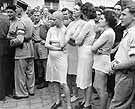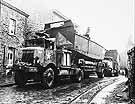
|
|
|

|

|

|

|
|
Click on an image to see a larger, more detailed picture.
|
|
|
|
|
| 1945: Liberation and Rebuilding |

|
pg. 588 |

|
|
|
|
| |
 These four French women were accused of collaborating with the Germans while France was occupied during the war. After the war, revenge was exacted upon female collaborators through such acts of public humiliation as shaving their heads and undressing them. Male collaborators were often treated even more harshly--sentenced to prison or executed. Yet many important collaborators escaped punishment for years, being protected by influential French government and Catholic Church officials.
These four French women were accused of collaborating with the Germans while France was occupied during the war. After the war, revenge was exacted upon female collaborators through such acts of public humiliation as shaving their heads and undressing them. Male collaborators were often treated even more harshly--sentenced to prison or executed. Yet many important collaborators escaped punishment for years, being protected by influential French government and Catholic Church officials.
Photo: Hulton Getty Images
|
 Allied troops moving eastward knew that the Rhine River was the last great natural barrier to Germany's heartland. The U.S. Ninth Armored Division crossed the river at a bridge the Germans had left intact, at Remagen, on March 7, 1945, inflicting upon Germany a crushing strategic and psychological defeat. Two days later the bulk of the U.S. Third Army reached the Rhine, bringing up the curtain on the penultimate military act of World War II in Europe.
Allied troops moving eastward knew that the Rhine River was the last great natural barrier to Germany's heartland. The U.S. Ninth Armored Division crossed the river at a bridge the Germans had left intact, at Remagen, on March 7, 1945, inflicting upon Germany a crushing strategic and psychological defeat. Two days later the bulk of the U.S. Third Army reached the Rhine, bringing up the curtain on the penultimate military act of World War II in Europe.
Photo: Archive Photos
|
 This March 1945 photograph is one of the last images of the living Adolf Hitler. Still suffering the effects of physical injury from the July 1944 assassination attempt and loaded with recklessly prescribed drugs, he greeted members of the Hitler Youth in Berlin as the Red Army moved virtually unchecked toward the city. Amidst an atmosphere of suffering, chaos, and anger, the naive Hitler Youth was among the few Nazi groups to remain wholly loyal to the Führer.
This March 1945 photograph is one of the last images of the living Adolf Hitler. Still suffering the effects of physical injury from the July 1944 assassination attempt and loaded with recklessly prescribed drugs, he greeted members of the Hitler Youth in Berlin as the Red Army moved virtually unchecked toward the city. Amidst an atmosphere of suffering, chaos, and anger, the naive Hitler Youth was among the few Nazi groups to remain wholly loyal to the Führer.
Photo: Bundesarchiv
|
|

|

|

|

|
 January 17, 1945: SS guards at the Chelmno, Poland, death camp play "William Tell" by shooting at bottles placed on the heads of Jewish inmates who have been engaged in demolishing the camp's crematoria. In the evening, the remaining Jews are led from their barracks in groups of five and shot. One of the prisoners, Mordechai Zurawski, stabs an SS guard and escapes despite suffering a gunshot wound to the foot. A second inmate, Shimon Srebnik, also survives after being shot through the neck and mouth and left for dead. Forty-seven other Jewish prisoners at Chelmno, aware that the SS will shoot them before fleeing west ahead of the Soviets, take refuge in a building that is then set afire by the SS. Jews who run from the blaze are machine-gunned; only one of the original 47 survives. The SS abandons the Chelmno camp later in the day.
January 17, 1945: SS guards at the Chelmno, Poland, death camp play "William Tell" by shooting at bottles placed on the heads of Jewish inmates who have been engaged in demolishing the camp's crematoria. In the evening, the remaining Jews are led from their barracks in groups of five and shot. One of the prisoners, Mordechai Zurawski, stabs an SS guard and escapes despite suffering a gunshot wound to the foot. A second inmate, Shimon Srebnik, also survives after being shot through the neck and mouth and left for dead. Forty-seven other Jewish prisoners at Chelmno, aware that the SS will shoot them before fleeing west ahead of the Soviets, take refuge in a building that is then set afire by the SS. Jews who run from the blaze are machine-gunned; only one of the original 47 survives. The SS abandons the Chelmno camp later in the day.
|
|
|
|
|
| 1945: Liberation and Rebuilding |

|
pg. 588 |

|
|
The Holocaust Chronicle
© 2009 Publications International, Ltd.
|
|
